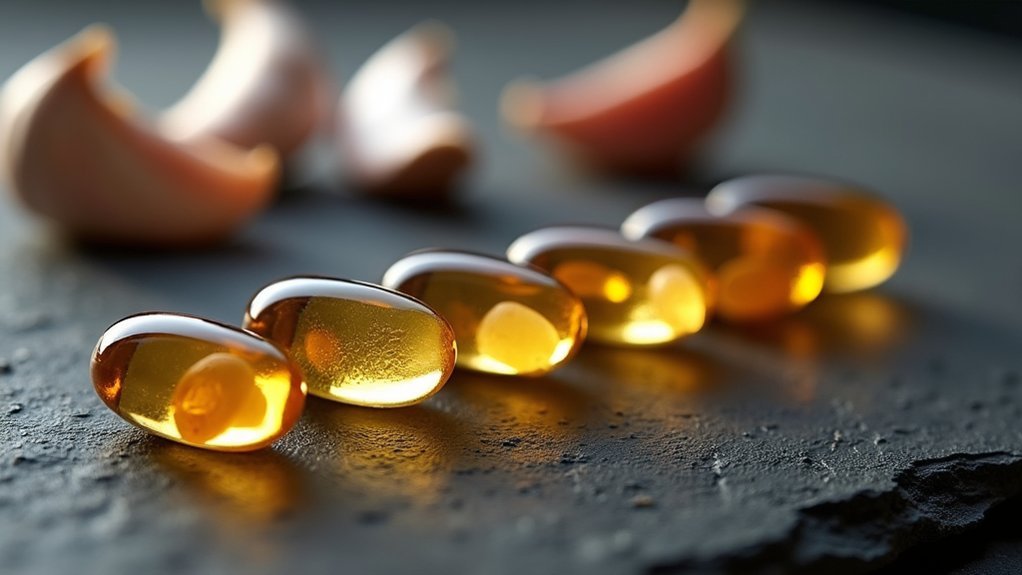You can spot omega-3 deficiency through persistent joint discomfort, morning stiffness, and reduced mobility without obvious injury. Your body needs omega-3s to reduce inflammatory mediators that damage cartilage and cause pain. Fatty fish like salmon provide over 2,000mg of EPA and DHA per serving, while supplements should contain 2.7 grams daily for therapeutic effects. Track your progress with pain journals and blood tests to monitor omega-3 levels. These strategies will help you understand the complete connection.
Recognize Early Warning Signs of Omega-3 Deficiency in Your Joints

Have you noticed persistent joint discomfort that doesn’t stem from an obvious injury or arthritis diagnosis? You might be experiencing omega-3 deficiency. Pay attention to chronic joint pain that appears without clear cause, especially if it’s accompanied by morning stiffness or reduced range of motion.
Watch for subtle changes like occasional mild stiffness before full pain develops, or joint fatigue during routine tasks. If you’re hearing more cracking sounds from your joints or experiencing swelling that worsens with activity, these could signal deficiency.
Don’t ignore accompanying symptoms like dry skin, fatigue, or mood changes alongside joint discomfort. If your joint pain doesn’t improve with rest or hydration alone, consider whether you’re getting adequate omega-3s through fish, flaxseeds, or walnuts. Research suggests that omega-3 supplements may help reduce joint pain and increase grip strength in affected individuals.
Understand How Omega-3 Fatty Acids Reduce Joint Inflammation
When omega-3 fatty acids enter your joint tissues, they fundamentally alter how your body produces and responds to inflammatory signals.
EPA and DHA change your cell membrane composition, reducing arachidonic acid content and shifting your inflammatory mediator production patterns. You’ll produce fewer pro-inflammatory eicosanoids and more inflammation-resolving compounds called resolvins.
These fatty acids inhibit your immune cells’ ability to migrate to inflamed joints by suppressing adhesion molecules and reducing leukocyte-endothelial interactions.
Your body produces fewer pro-inflammatory cytokines while maintaining better cartilage homeostasis. In rheumatoid arthritis, you’ll experience reduced morning stiffness and joint pain with proper omega-3 supplementation.
For osteoarthritis, omega-3s slow cartilage degradation by moderating chronic low-grade inflammation and reducing synovitis. The chronic inflammation in osteoarthritis affects not only cartilage but also synovium and ligaments, contributing to worsening symptoms throughout the joint structure.
Identify the Best Food Sources for Joint-Supporting Omega-3s

Understanding how omega-3s combat joint inflammation leads directly to making smart dietary choices that maximize these benefits.
You’ll find the highest concentrations in fatty fish like salmon, mackerel, and herring, each providing over 2,000mg of EPA and DHA per 100g serving. These marine sources deliver the most bioavailable forms your joints need.
If you’re avoiding fish, cod liver oil supplies 2,438mg per tablespoon, while algal oil offers a plant-based EPA/DHA alternative.
For vegetarian options, ground flaxseeds pack 6.7 grams of ALA per ounce, followed by chia seeds at 5 grams. Walnuts provide 2.7 grams ALA per ounce and make convenient snacks. Wild-caught fish may contain higher omega-3 levels than their farmed counterparts, making them an even better choice for joint health support.
Choose the Right Omega-3 Supplement for Joint Pain Relief
While incorporating omega-3-rich foods provides excellent joint support, you’ll likely need supplements to reach therapeutic doses for significant pain relief. Research suggests taking 2.7 grams of EPA and DHA daily for reducing joint inflammation in rheumatoid arthritis.
Research indicates that achieving therapeutic omega-3 levels for joint pain relief typically requires 2.7 grams of EPA and DHA supplementation daily.
When selecting supplements, prioritize quality brands like Nordic Naturals that undergo third-party testing for purity and potency. Look for clear label claims about omega-3 content and verify the product’s free from contaminants and allergens.
Consider your preferences regarding form—soft gels, capsules, or liquid options are available. Some products combine omega-3s with vitamin D or antioxidants for enhanced benefits. For those following plant-based diets, algal oil serves as an excellent alternative since it contains both EPA and DHA unlike other plant sources.
Evaluate cost-effectiveness while prioritizing quality, and choose brands committed to sustainable sourcing. Always consult healthcare professionals before combining supplements with existing medications.
Track Your Progress When Adding Omega-3s to Your Joint Health Routine

After starting omega-3 supplementation for joint health, you’ll want to establish a systematic approach to monitor your progress and measure the effectiveness of your new routine.
Consider getting blood tests to measure your omega-3 levels and track changes over time. These tests provide personalized insights that help you adjust dosages or dietary intake accordingly.
Track your symptoms regularly using standardized tools like WOMAC scores, which evaluate pain, stiffness, and functional limitations. Document daily pain levels, joint mobility, and overall comfort to identify patterns and improvements.
You’ll also want to assess your dietary sources of omega-3s to guarantee adequate intake from foods like fish, flaxseed, and walnuts. Monitor your CRP levels as omega-3s work to decrease these inflammatory markers that contribute to joint pain and stiffness.
Consult your healthcare professional regularly to review progress and make necessary adjustments to your joint health routine.
Frequently Asked Questions
How Long Does It Take for Omega-3s to Start Reducing Joint Pain?
You’ll typically notice omega-3s reducing your joint pain after two to three months of consistent supplementation. Your body needs this time to build up anti-inflammatory levels and reduce inflammation markers affecting your joints.
Can Omega-3 Deficiency Cause Permanent Joint Damage if Left Untreated?
Omega-3 deficiency won’t directly cause permanent joint damage, but it’ll increase chronic inflammation that can lead to irreversible cartilage breakdown and structural changes if you don’t address it.
Are There Any Side Effects of Taking Omega-3 Supplements for Joints?
You might experience mild digestive issues like diarrhea, nausea, or stomach upset when taking omega-3 supplements. Fishy breath, burping, and occasional headaches can occur, but they’re generally well-tolerated overall.
What’s the Difference Between EPA and DHA for Joint Health Benefits?
EPA’s more effective for joint health because it directly produces anti-inflammatory eicosanoids that reduce joint pain and inflammation. While DHA supports overall cellular health, you’ll get better joint-specific benefits from EPA supplementation.
Can Children With Joint Pain Safely Take Omega-3 Supplements?
You should consult your child’s pediatrician before giving omega-3 supplements for joint pain. While they’re generally safe and show anti-inflammatory benefits, proper dosing and monitoring are essential for children’s safety.
In Summary
You’ve learned how omega-3 deficiency connects to joint pain and discovered practical ways to address it. Don’t ignore early warning signs in your joints – they’re telling you something important. Start incorporating omega-3-rich foods into your meals, choose quality supplements when needed, and track your progress consistently. Your joints will thank you as inflammation decreases and mobility improves. Take action today – your future self depends on the choices you make now.





Leave a Reply